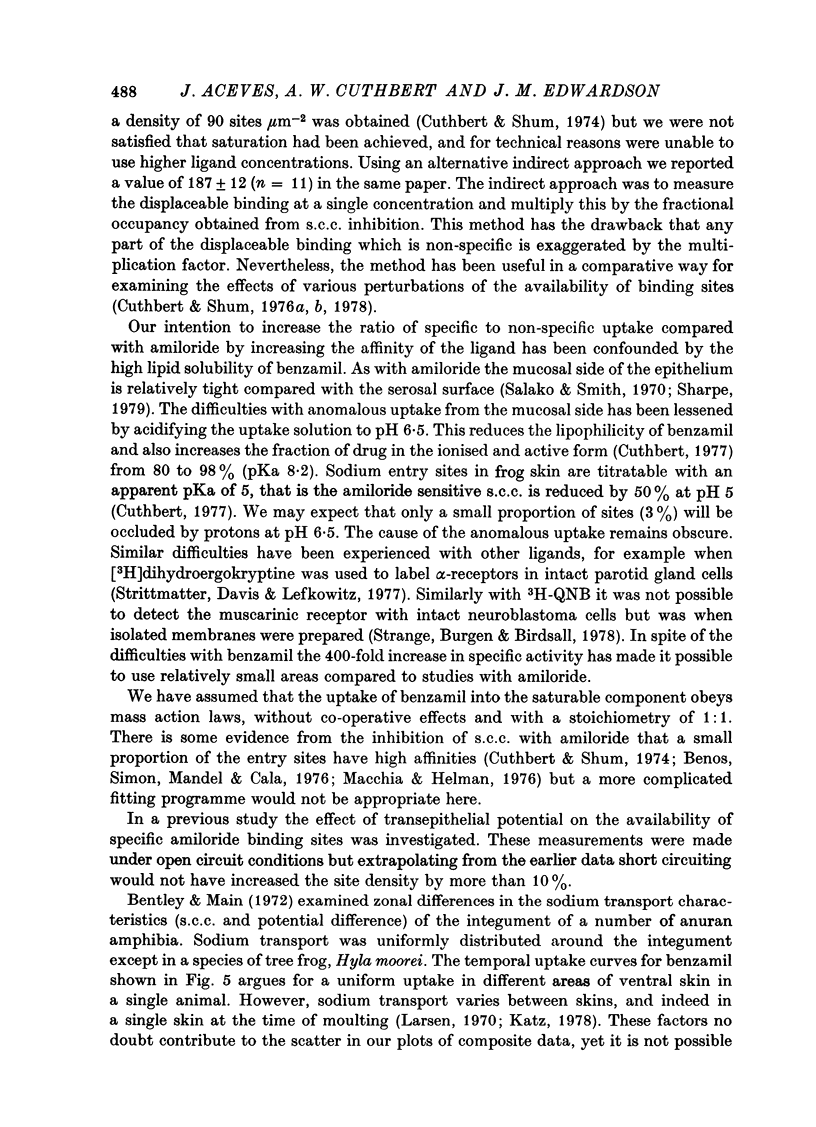Abstract
1. The inhibition of short circuit current in frog skin by benzamil (N-benzyl-amidino-3,5-diamino-6-chloropyrazine carboxamide) was investigated. When skins were bathed on both sides by Ringer solution (pH 7.6) the affinity was 5 x 10(7) M-1. When the sodium concentration was reduced to 1.1 mM and the pH adjusted to 6.5 the affinity increased to 8.5 x 10(8) M-1. 2. A method is described for measuring uptake of [3H]benzamil into the mucosal (outer) surface of pieces of isolated epithelium, 0.95 cm2 in area, under open circuit conditions. 3. The relation of [3H]benzamil uptake at the mucosal surface to its concentration was measured in solutions containing 1.1 mM-sodium and adjusted to pH 6.5. Uptake could be resolved into a linear component (10.2 f-mole nM-1) and a saturable component (21.5 f-mole cm-2) with a half saturating concentration of 1 nM. 4. In the presence of amiloride (1 microM) or unlabelled benzamil (1 microM) uptake was linear with concentration, and was, respectively, 9.2 f-mole nM-1 and 8.8 f-mole nM-1. When the pH was reduced to 3.5 uptake was again linear but reduced to 3.3 f-mole nM-1. 5. The identity of the saturable component of [3H]benzamil uptake to sodium entry sites is discussed. The results suggest a sodium entry site density of around 130 micron-2 of mucosal surface.
Full text
PDF













Selected References
These references are in PubMed. This may not be the complete list of references from this article.
- Aceves J., Cuthbert A. W., Edwardson J. M. A new ligand for epithelial sodium channels [proceedings]. J Physiol. 1978 Sep;282:24P–26P. [PubMed] [Google Scholar]
- Aceves J., Erlij D. Sodium transport across the isolated epithelium of the frog skin. J Physiol. 1971 Jan;212(1):195–210. doi: 10.1113/jphysiol.1971.sp009317. [DOI] [PMC free article] [PubMed] [Google Scholar]
- Benos D. J., Simon S. A., Mandel L. J., Cala P. M. Effect of amiloride and some of its analogues of cation transport in isolated frog skin and thin lipid membranes. J Gen Physiol. 1976 Jul;68(1):43–63. doi: 10.1085/jgp.68.1.43. [DOI] [PMC free article] [PubMed] [Google Scholar]
- Bentley P. J. Amiloride: a potent inhibitor of sodium transport across the toad bladder. J Physiol. 1968 Mar;195(2):317–330. doi: 10.1113/jphysiol.1968.sp008460. [DOI] [PMC free article] [PubMed] [Google Scholar]
- Bentley P. J., Main A. R. Zonal differences in permeability of the skin of some anuran Amphibia. Am J Physiol. 1972 Aug;223(2):361–363. doi: 10.1152/ajplegacy.1972.223.2.361. [DOI] [PubMed] [Google Scholar]
- Biber T. U., Sanders M. L. Influence of transepithelial potential difference on the sodium uptake at the outer surface of the isolated frog skin. J Gen Physiol. 1973 May;61(5):529–551. doi: 10.1085/jgp.61.5.529. [DOI] [PMC free article] [PubMed] [Google Scholar]
- Catterall W. A., Morrow C. S. Binding to saxitoxin to electrically excitable neuroblastoma cells. Proc Natl Acad Sci U S A. 1978 Jan;75(1):218–222. doi: 10.1073/pnas.75.1.218. [DOI] [PMC free article] [PubMed] [Google Scholar]
- Cuthbert A. W. An upper limit to the number of sodium channels in frog skin epithelium. J Physiol. 1973 Feb;228(3):681–692. doi: 10.1113/jphysiol.1973.sp010106. [DOI] [PMC free article] [PubMed] [Google Scholar]
- Cuthbert A. W., Fanelli G. M. Effects of some pyrazinecarboxamides on sodium transport in frog skin. Br J Pharmacol. 1978 May;63(1):139–149. doi: 10.1111/j.1476-5381.1978.tb07783.x. [DOI] [PMC free article] [PubMed] [Google Scholar]
- Cuthbert A. W. Importance of guanidinium groups of blocking sodium channels in epithelia. Mol Pharmacol. 1976 Nov;12(6):945–957. [PubMed] [Google Scholar]
- Cuthbert A. W., Shum W. K. Characteristics of the entry process for sodium in transporting epithelia as revealed with amiloride. J Physiol. 1976 Mar;255(3):587–604. doi: 10.1113/jphysiol.1976.sp011297. [DOI] [PMC free article] [PubMed] [Google Scholar]
- Cuthbert A. W., Shum W. K. Effects of vasopressin and aldosterone on amiloride binding in toad bladder epithelial cells. Proc R Soc Lond B Biol Sci. 1975 Jun 17;189(1097):543–575. doi: 10.1098/rspb.1975.0072. [DOI] [PubMed] [Google Scholar]
- Cuthbert A. W., Shum W. K. Induction of transporting sites in a sodium transporting epithelium. J Physiol. 1976 Aug;260(1):223–235. doi: 10.1113/jphysiol.1976.sp011512. [DOI] [PMC free article] [PubMed] [Google Scholar]
- Cuthbert A. W., Shum W. K. Interdependence of the two borders in a sodium transporting epithelium. Possible regulation by the transport pool. J Membr Biol. 1978;40(Spec No):221–245. doi: 10.1007/BF02026008. [DOI] [PubMed] [Google Scholar]
- Ehrlich E. N., Crabbé J. The mechanism of action of amipramizide. Pflugers Arch. 1968;302(1):79–96. doi: 10.1007/BF00586783. [DOI] [PubMed] [Google Scholar]
- Eigler J., Kelter J., Renner E. Wirkungscharakteristika eines neuen Acylguanidins--Amiloride-HCL (MK 870)--an der isolierten Haut von Amphibien. Klin Wochenschr. 1967 Jul 15;45(14):737–738. doi: 10.1007/BF01746103. [DOI] [PubMed] [Google Scholar]
- Larsen E. H. Sodium transport and D.C. resistance in the isolated toad skin in relation to shedding of the stratum corneum. Acta Physiol Scand. 1970 Aug;79(4):453–461. doi: 10.1111/j.1748-1716.1970.tb04745.x. [DOI] [PubMed] [Google Scholar]
- Lindemann B., Van Driessche W. Sodium-specific membrane channels of frog skin are pores: current fluctuations reveal high turnover. Science. 1977 Jan 21;195(4275):292–294. doi: 10.1126/science.299785. [DOI] [PubMed] [Google Scholar]
- Salako L. A., Smith A. J. Changes in sodium pool and kinetics of sodium transport in frog skin produced by amiloride. Br J Pharmacol. 1970 May;39(1):99–109. doi: 10.1111/j.1476-5381.1970.tb09559.x. [DOI] [PMC free article] [PubMed] [Google Scholar]
- Strange P. G., Birdsall N. J., Burgen A. S. Ligand-binding propeties of the muscarinic acetylcholine receptor in mouse neuroblastoma cells. Biochem J. 1978 Jun 15;172(3):495–501. doi: 10.1042/bj1720495. [DOI] [PMC free article] [PubMed] [Google Scholar]
- Strittmatter W. J., Davis J. N., Lefkowitz R. J. alpha-Adrenergic receptors in rat parotid cells. I. Correlation of [3H]dihydroergocryptine binding and catecholamine-stimulated potassium efflux. J Biol Chem. 1977 Aug 10;252(15):5472–5477. [PubMed] [Google Scholar]


